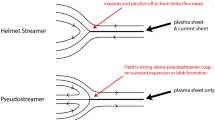Abstract
If an accretion disk gets hotter than a few MeV, nuclei in the infailing matter are dissociated into their constituent neutrons and protons. Neutrons released by dissociation of matter falling at high accretion rates into a black hole or neutron star accumulate in a dense 'neutron torus'. Matter in accretion disks around compact objects like those responsible for galactic X-ray sources may thus provide ideal conditions for classical rapid or r-process nucleosynthesis1. Systems in which accretion powers an outflow from a region near the compact object might thereby enrich the interstellar medium in r-process elements. These elements are usually thought to originate in other stellar environments, such as helium shell-flash, supernovae and tidally dispersed neutron stars2–5. Nucleosynthesis of lighter elements (C,N,O...) in accretion disks has been discussed recently in refs 6 and 7; the r-process mechanism considered here was inspired by some ideas8,9 for manufacturing deuterium in pregalactic accretion disks.
Similar content being viewed by others
References
1. Burbidge, E. M., Burbidge, G. R., Fowler, W. A. & Hoyle, F. Rev. mod. Phvs. 29, 547-??? (1957). 2. Schramm, D. N. in Essays in Nuclear Astrophysics (eds Barnes, C. A., University Press, Clayton, D. D. & Schramm, D. N.) 325-354 (Cambridge University Press, 1982). 3. Mathews, G. J. & Ward, R. A. Rep. Prog. Phys. 48, 1371 (1985). 4. Audouze, J., in Saas-fee School, The Origin of the Elements (in the press). 5. Lattimer, J. & Schramm, D. N. Astrophys. J. 192, L145-L147 (1974). 6. Chakrabarti, S. K., Jin, L. & Arnett, W. D. Astrophys. J. (submitted). 7. Chakrabarti, S. in Proc VI Moriond Comp: Accretion in Compact Objects (in the press). 8. Ramadurai, S. & Rees, M. J. Mon. Not. R. astr. Soc. 215, 53P-56P (1985). 9. Aharonian, F. A. & Sunyaev, R. A. Mon. Not. R. astr. Soc. 210, 257-277 (1984). 10. Rees, M. J., Begelman, M. C., Blandford, R. D. & Phinney, E. S. Nature 295, 17-21 (1982). 11. Eardley, D. M., Lightman, A. P., Payne, D. G. & Shapiro, S. L. Astrophys. J. 224,53-61 (1978). 12. Shapiro, S. L., Lightman, A. P. & Eardley, D. M. Astrophys. J. 204, 187 (1976). 13. Wasserburg, G. & Papanastassiou, D. A. in Essays in Nuclear Astrophysics, (eds Barnes, C.A., Clayton, D. D., Schramm, D. N.) 77-140 (Cambridge University Press, 1982). 14. Sneden, C. & Parathasarathy, M. Astrophys. J. 267, 757-778 (1983). 15. Sneden, C. & Pilachowski, C. A. Astrophys. J., 288, L55-L58 (1985). 16. Smak, J. Publs Astr. Soc. Pacif. 96, 5-18 (1984).
Author information
Authors and Affiliations
Rights and permissions
About this article
Cite this article
Hogan, C., Applegate, J. Neutron tori and the origin of r-process elements. Nature 330, 236–238 (1987). https://doi.org/10.1038/330236a0
Received:
Accepted:
Issue Date:
DOI: https://doi.org/10.1038/330236a0
- Springer Nature Limited
This article is cited by
-
Constraints on r-process nucleosynthesis in accretion disks
Nature (1991)
-
New insights into the astrophysical r-process
Nature (1990)





